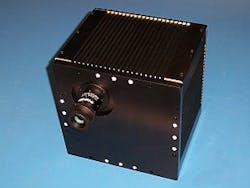The InView 220 includes a sensor and sensor controller for development and testing of compressive sensing algorithms. The sensor includes an objective lens, a 1920 × 1080 TI DMD with a mirror update rate of 10 kHz, a 4 × 8 SWIR detector array, and an analog-to-digital converter.
InView Technology
Austin, TX
[email protected]
More Products
-----
PRESS RELEASE
InView Announces Compressive Sensing Workstation
Austin, TX: InView Technology Corporation, the world leader in Compressive Sensing (CS) imaging products, has launched the first in a series of CS Workstations. The InView220 provides CS researchers with the ability to easily prototype and test novel CS algorithms on a complete hardware imaging platform. Researchers are provided with unprecedented ability to apply novel measurement bases to a high-speed, high-definition spatial light modulator, and to process the light levels measured from Shortwave Infrared (SWIR) detectors.
The major components of the InView220 are an imaging Sensor, which includes a 1920x1080 digital micromirror device and a 32-diode detector array, and a Sensor Controller, which is preloaded with the InView Development Environment (IDE) software.
âUntil today, researchers have been forced to build and program complex bench-top systems in order to test CS algorithms on real images. InViewâs new CS Workstations allow scientists to focus their time on the science instead of the hardware,â stated Dr. Kevin Kelly, InViewâs co-founder and Professor at Rice University. âThe InView220 will expedite the development of practical high-performance Compressive Sensing-based cameras and hyperspectral imagers.â
InView220 Description
The InView220 includes both a Sensor and a Sensor Controller, allowing the user to develop and test Compressive Sensing algorithms, including custom measurement bases and custom reconstruction code.
The Sensor is a complete electro-optical system. It includes an objective lens, a 1920x1080 TI DMD with a mirror update rate of 10 kHz, a 4 by 8 SWIR detector array, and an analog-to-digital converter. The Sensor segments the scene into 32 distinct sub-images. Each sub-image, or aperture, can be treated as its own âsingle-pixelâ camera. The Sensor employs multiple FPGA devices in order to achieve high-speed performance, including full-rate updates of the DMD patterns.
The Sensor Controller manages the Sensor and provides an 8-core computing platform for the development and testing of custom compressive sensing software. User defined modulation patterns, custom data processing and novel reconstruction algorithms can be rapidly applied and experimentally tested in a stand-alone system without lengthy set-up times. The Sensor and Controller are connected by a high-speed PCI Express interface.
The InView220 is based on InViewâs extensive portfolio of CS-related intellectual property.
About InView
InView specializes in the design, development and manufacturing of low-cost SWIR cameras for commercial and laboratory applications. Leveraging its patents in Compressive Sensing, InViewâs InGaAs-based solutions can achieve superior results at dramatically reduced prices, and provide leadership price-performance for security, surveillance, maritime navigation, military and other applications.
For more information on the product, please contact: [email protected]
-----
Follow us on Twitter
Laser Focus World has gone mobile: Get all of the mobile-friendly options here.
Subscribe now to Laser Focus World magazine; it's free!
Sponsored Recommendations
Sponsored Recommendations
Request a free Micro 3D Printed sample part
April 11, 2024
How to Tune Servo Systems: The Basics
April 10, 2024
Voice your opinion!
Voice your opinion!
